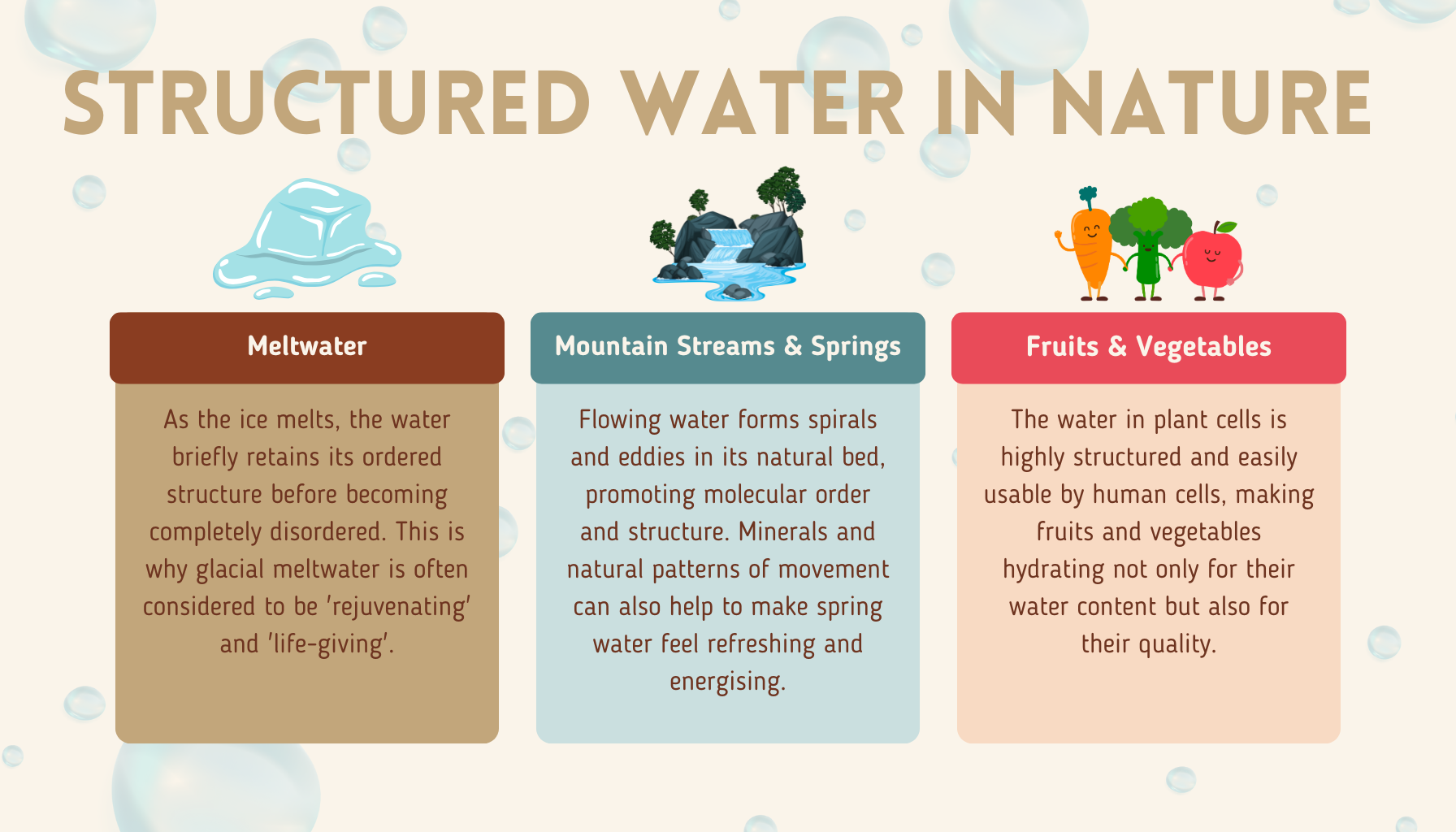
29 Apr Structured Water: The Missing Link to Your Vitality?
Structured water is when the water molecules, instead of moving around randomly as they usually do in normal tap water, form some sort of organised, repeating pattern, often described as crystalline, hexagonal or snowflake-like. This molecular order is thought to affect the physical and energetic properties of the water, which in turn could affect how well our bodies function.
In this article, you’ll find out what structured water is, why it’s important for your overall wellbeing, and some ways to do it.
Why Is The Molecular Structure of Water Important?
Living organisms, including humans, are about 60-70% water. In our cells, however, water is not just a passive ‘filler’ or solvent. Dr Gerald Pollack says that the water in our bodies, especially in our cells, tends to be more structured than the water we usually drink. His research into ‘exclusion zone water’, also known as the ‘fourth phase of water’, in addition to the three known phases of solid (ice), liquid and vapour (steam), suggests that structured water may exist naturally in biological systems. This structured water may play an active role in cellular communication, energy transfer and biochemical reactions.

The way the water molecules are arranged can make a difference to how the water behaves, both in terms of its physical and energetic properties. Water with a higher degree of structural organisation is thought to help nutrients get into cells more easily, keep cells hydrated (because it’s thought that structured water can get into cells more easily), aid detoxification by helping to remove waste products, and improve bioelectrical signalling in the body.
It’s the same way that the right arrangement of building blocks determines the strength of a house. The arrangement of water molecules could also determine how well water supports life processes at the cellular level. You can also think of water molecules as little magnets. In ordinary water, these ‘magnets’ are scattered in all directions. In structured water, however, they line up neatly, like soldiers on parade or the perfectly ordered cells of a honeycomb.
The Role of Water Structure in Energy and Information Transfer
Some researchers and proponents of structured water suggest that water has the capacity to store and transmit information, much like a liquid crystal. This idea is connected to the controversial but intriguing studies of Masaru Emoto, who photographed water crystals after exposing the water to different words, music, or intentions — claiming that positive emotions or intentions led to more harmonious, beautiful crystal formations.

One of the great benefits of eating fruit is that, in addition to vitamins and trace elements, we get water in a structured form, which makes it much easier for our bodies to absorb and assimilate.
While these ideas are still up for debate in mainstream science, they point to a bigger theory: that the way water is structured might affect how well it can carry subtle energies or information, which could be having an effect on biological systems that we’re just starting to understand.
What is Egely Wheel? Find out here.
What Happens When Water Is Unstructured?
When water is exposed to heavy industrial processing, long periods of stagnation, microwave radiation, or certain types of chemical treatments, the natural ordering of its molecules can be disrupted. According to structured water proponents, drinking such disordered water may still hydrate your body to some degree, but may not support optimal cellular function as effectively as structured water.
How Can Water Become Structured Again?
In nature, water often flows in spirals, curves and vortices, whether it’s in rivers, streams or underground aquifers. This movement seems to be very important for the organisation of water’s molecular structure. When water is stagnant (in pipes, tanks or bottles) or heavily processed (chlorinated, microwaved, etc.), this natural structure can break down. Many people interested in structured water believe that water molecules can be reorganised or ‘revitalised’ using specific methods that copy the forces and patterns found in nature.
Here are some of the most common water structuring methods:
Vortexing (Spiraling the water)
Spinning water creates a vortex that mimics the flow of rivers and streams. Some devices are designed to swirl the water mechanically, while others suggest simply stirring the water vigorously one way and then the other.

Passing water through crystals or natural materials
Certain stones such as quartz, shungite or tourmaline are believed to promote molecular organisation. Special ceramics or bioresonance materials are also used in some water structuring devices.
DID YOU KNOW?
The Living Structured Water: The Role of Plants and Fruits

It’s interesting to note that water is present in fresh fruit and vegetables in a highly organised, bioavailable form. Bioavailability is how much of a substance (like a vitamin, drug or dietary supplement) you take actually reaches your bloodstream, so your body can use it. This may explain why eating hydrating and ‘living’ foods such as cucumber, watermelon or oranges can often feel more refreshing and satisfying than drinking plain water or processed juices. Dr. Gerald Pollack’s research suggests that the structured water in our bodies is not just a passive medium, but actually plays an active role in cellular life processes.
When it comes to structured water, it’s not always about investing in high-end equipment – sometimes the solution is as simple as this: Try to eat more raw, fresh plant foods and drink only from flowing natural sources (where safe and possible). Also, try to respect the natural properties of water in your daily life.
Magnetic or electromagnetic treatment
Applying magnetic fields to water is thought to affect the hydrogen bonds between water molecules, promoting a more ordered state.
Exposure to sound vibrations or frequencies
Sounds, including mantras, singing bowls, tuning forks, or certain music (especially harmonic or classical), can affect the vibrational state of water and promote structure.
Sunlight charging (‘Solarising’ water)
Leaving water in glass containers (sometimes blue bottles) under natural sunlight is another traditional method believed to energise and structure water.
Using commercial structured water devices
There are now a variety of systems available on the market that claim to restructure water using combinations of the above methods — vortexing, magnetism, crystals, or ceramics.
Start measuring today
The Egely Wheel is trusted by thousands of people who practice yoga, telekinesis, meditation and healing. This device is the best solution for measuring your energy flow and efficiency of healing, and you get instant feedback.
Why Is Structured Water Important for Your Health and Vitality?
The idea behind structured water suggests that hydration is not just about drinking enough water — it’s about how well that water integrates into your body’s systems.
If structured water really does all of this, entering cells more easily, supporting better nutrient absorption, facilitating detoxification, improving cellular communication, then you may find that drinking structured water helps you stay hydrated without having to drink as much water, gives you more energy and makes you feel more resilient.
In addition, proponents argue that because the body spends less energy ‘processing’ structured water, it has more resources available for repair, regeneration and performance. Structured water may also play a role in:
- Balancing electrolytes
- Reducing inflammation
- Supporting healthy mitochondrial function (the “power plants” of your cells)
- Improving the body’s natural detox pathways
Structured Water and Functional Medicine: A Holistic View
The idea of structured water fits really well with the whole functional medicine approach, which is all about treating the root causes of health problems rather than just the symptoms. Functional medicine practitioners often look at hydration not just as a matter of fluid intake, but as part of a complex web of systems:
- How well is your digestion working?
- Do your cells have what they need to thrive?
- Are there any inflammatory processes or toxic exposures that could be messing with the water balance at the cellular level?
So, from this point of view, structured water could be one more tool — along with nutrition, stress management, getting enough sleep, and exercise — that helps restore the body’s natural balance and vitality.
Final Thoughts: Quality Over Quantity
When it comes to water and health, the conversation is moving on from just “drink eight glasses a day.” So, the question is, what kind of water are you putting into your body? Whether it’s the natural structure of plant-based hydration or methods that mimic nature’s own processes, structured water makes us think differently about this everyday substance — not just as hydration, but as a potential carrier of life energy itself.
At the end of the day, the most important thing is to listen to your body, be curious, and find out what really supports your well-being. Take care of your health and you’ll find it’s always easier — and more rewarding — than trying to fix it later.
7 Sources +
Egely Wheel has strict sourcing guidelines and relies on peer-reviewed studies, academic research institutions, and medical associations. We avoid using tertiary references.
- What is functional medicine? – https://www.ifm.org/
- A Functional Medicine Perspective On Structured Water – https://drwillcole.com/
- Structured Water: What Is It and Is It Worth the Hype? – https://primehealthdenver.com/
- Structured Water: Definition, Benefits, Research, and More – https://www.healthline.com/
- Evidence for Alteration in Chemical and Physical Properties of Water and Modulation of its Biological Functions by Sunlight Transmitted through Color Ranges of the Visible Spectrum-A Novel Study – https://pmc.ncbi.nlm.nih.gov/
- Exclusion Zone Phenomena in Water—A Critical Review of Experimental Findings and Theories – https://pmc.ncbi.nlm.nih.gov/
- Updated view about the rice experiments of Masaru Emoto – https://www.researchgate.net/

